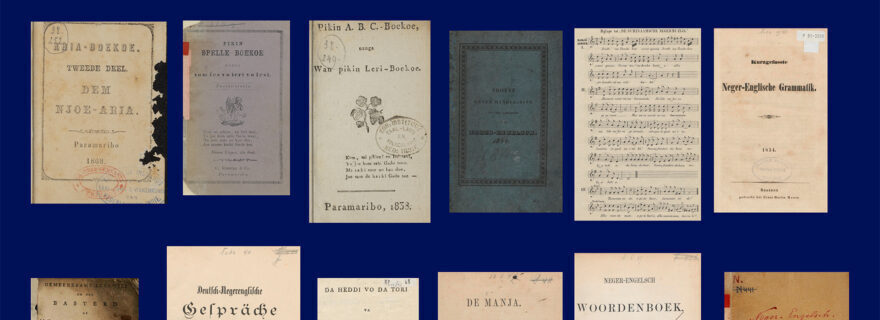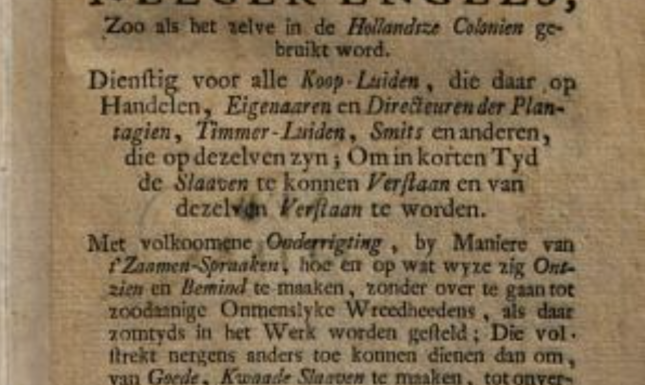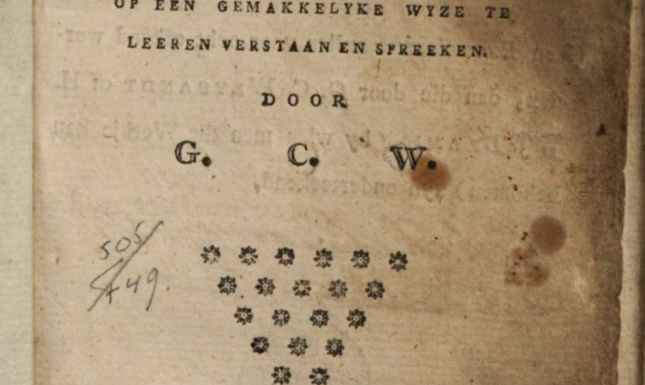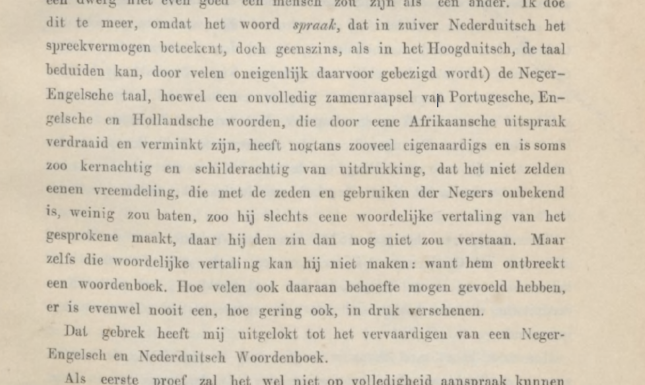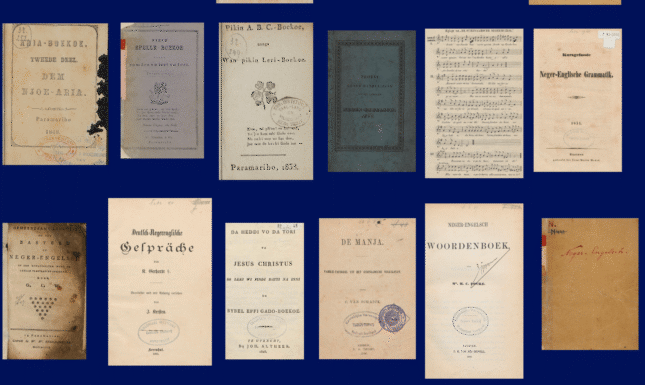'So Crisp and Scenic' - Early Sranan and the Birth of a New Age
The Sranan language, an English-based creole spoken by people of Suriname, has a long and fascinating history and is gaining popularity as a written language. Fresco Sam-Sin talks about the history of Sranan and shares his own story.
This blog was previously published on the LeidenSpecialCollections blog.
I am one of many Surinamese born in the Netherlands. My father arrived in the Netherlands in 1965. As you say in Sranan, the lingua franca of many people with roots in Suriname: yu papa dati na yu brudu ('your dad, that's your blood')1. This blog is about the status of Sranan, an English-based creole that emerged from the plantations in Suriname at the end of the 17th century. We will look at the Sranan pages in the Special Collections at Leiden University Libraries2 as a way to empower Sranan's Birth of a New Age.
Growing up, I knew of Sranan, but my father never used it with me. At family gatherings, I could overhear my grandparents using Sranan with other relatives. On such occasions, my father still refrained from using the language. An old habit, so I learnt, because when he was little, his parents discouraged him from using the language, despite my grandmother often mentioning how much better her stories are when told in Sranan.3 Like my father, many children grew up with an ambivalent attitude towards Sranan: on the one hand, it made them feel Surinamese, but at the same time they were told (and taught) that Sranan was not a "real" language; that it was for chit chat (taki taki) of the uneducated folk. All of these convictions are rooted in Suriname's colonial past, and that past is recorded in the Special Collection. How we read that collection is a choice that we can make in the present. This blog is my take.
"For the entertainment"
As a child of the Surinamese diaspora, for me, Sranan was just something that belonged to my father and his family, and I only picked up some phrases left and right, just for fun. The enslaved population also used Sranan for fun, to satisfy "the hunger to sing"4 (Fig. 1 and 2) and for love and lust5. It is with this lightness that the first Sranan words appeared in print6, listing some Sranan phrases for the fun of it; for the entertainment of the literate outsiders. The phrases were attached to a chapter in Beschrijvinge van de volksplantinge Zuriname ('Description of the Plantation of Suriname') (Fig. 3), dated 1718. Its compiler, J.H. Herlein ("a man of somewhat mysterious Dutch provenance"7) who stayed with friends in Paramaribo, introduced the phrases by saying:
To associate Sranan with entertainment, even during the horrors of plantation life, does not take away from the fact that its emergence was born out of pure necessity. Although they arrived at the coast of Suriname as one single "commodity", these were humans with families and ancestors of very different descent, covering areas from west to central Africa. Lacking a common language, Sranan emerged as a vehicle of communication amongst the enslaved communities, and as a mode to speak with the suppressors. Built upon the native tongues of the abusers, Sranan, in this sense, is a testimony of strength and resilience. That Herlein wanted to share it for the entertainment of the readers is not a problem, but a compliment.
"So Crisp and So Scenic"
Despite a long history of hegemony and belittlement by the colonial government and the evangelism by the Protestant and Catholic mission, these same institutions have always recognised the significance of Sranan, both in spoken and in written form, for better and for worse. It is the written form of Sranan that is only now growing in popularity amongst people of Surinamese heritage, and so it seems right to revisit early Sranan texts at this pivotal point in time. Instead of reading these texts as tools of oppression, I would like to focus on the elements that show the seriousness with which the oppressors and evangelists approached the language of the enslaved population.
On the surface, many of the early titles (1765 and 1798) in the Special Collection disqualify Sranan as a real language, calling it Basterd of Neger-Engelsch ('Bastard or Negro-English') (Fig. 5 and 6). For example, Dutchman Hendrik Focke (1802-1856), born and raised in the capital of Paramaribo, stated about Sranan in the introduction (Fig. 7 and 8) to his Neger-Engelsche woordenboek (‘Negro-English dictionary’):
"Negro-English, albeit a mishmash of Portuguese, English and Hollandish words, and being twisted and butchered by some sort of Africanic flavour, has so many idiosyncracities and does oftentimes express itself so crisp and so scenic that a foreigner, unfamiliar with the mores and customs of the Negroes, gains little should he translate the spoken language word by word, because, even then, he would not get the real meaning of the sentences."
"Fillers, interjections and sound mimicking vocabulary; [Sranan] has them in abundance. They are proof of a shabby, uncivilized language, uttered by people with vivid imagination and hefty emotions."
Looking beyond the derogatory judgements made about the enslaved population, Focke could not help but use some words of admiration for Sranan. He calls the Sranan formulation 'crisp' (kernachtig) and 'scenic' (schilderachtig). And, while comments such as 'vivid imagination' (levendige verbeeldingskracht) and 'hefty emotions' (hevige hartstogten) may have been dismissive in Focke's eyes and in the Dutch context of that time, they are qualities that Dutch society and our educational system have been promoting for decades now.
"Strong Love for his mother tongue"
In this same introduction, Focke also deemed it necessary to emphasize that, in his eyes, Sranan is a real language, with the following, peculiar comparison: "I use the word language, because I cannot see why a dwarf is not as much of a human as any other person." (Fig. 7) There were several instances where clergies went out of their way to defend the status of Sranan. In 1829 in a journal called The Edinburgh Christian Instructor, an attack was placed by Rev. Labrobe on an anonymous critic who proposed that Sranan was just jargon instead of a language in its own right8. If we could ask them today, none of these clergies would have agreed with the term taki taki, because they would find it an insult to the language that they came to love and defend.
Regardless of the many, almost dutifully dismissive remarks in publications on Sranan, the fact of the matter was that every single individual that wanted to engage with the community of slaves had to learn Sranan, and did so as they would learn any other language: by using a dictionary, pattern drills, written dialogues, etc. Sranan was a staple for anyone who wanted to dictate the plantations and the servants in the city of Paramaribo, and for conducting business and organising administration and governance.
In his preface to the 1798 Learning to read and to write Bastard or Negro-English Made Easy ('Gemeenzaame leerwyze om het Basterd of Neger-Engelsch op een gemakkelyke wyze te leeren verstaan en spreeken') (Fig 6) its compiler, Weygandt (whose 'concubine' was a freed slave and native speaker of Sranan9) lays out his goals: "To help the foreigner that comes to us, and therefore has to, for the first time, converse with the slaves..." and "to help those who live in Paramaribo, whose profession requires services..." (See Fig 9)
Yet another example of this is a manual by A. Helmig van der Vugt (Fig. 10). When his 1844 introduction to his Attempt at a manual to learn to understand and speak Negro-English as it is commonly spoken within the colony of Suriname, during the travels to there (Proeve eener handleiding, om het Neger-Engelsch, zoo als hetzelve over het algemeen binnen de kolonie Suriname gesproken wordt, gedurende de reis derwaarts te leeren verstaan en spreken). went to press, Van der Vugt was not aware of any other textbook. The reasons for that were clear, as was the need for one. In his words (Fig. 11):
It is because of this 'strong love' (Sterke liefde voor zijne moedertaal) and the fact that the people speak it with a sense of 'pride' (spreekt met eenen trots) that those travelling to Suriname would simply have to learn the language to use it in their contact with the 'lowest class of humans'10. Again, this textbook would not have been necessary if slavery had never happened, but that being said, the textbook again confirms that knowledge of Sranan felt quintessential for anyone travelling there. And, moreover, it is the 'love' and the 'pride' that we read in Van der Vugt's text that we can now choose to give the spotlight and take that with us towards a new phase for Sranan.
"Boen rai"
Boen rai (bun ray, as we would write it nowadays) is Sranan for 'good advice', something that the Surinamese enslaved population received enough of from its colonizers and evangelists. The impact of all the rai continued after the abolishment of slavery in 186311 and after Suriname's independence from the Netherlands in 1975. A lot of the advice in the 19th century had to do with either administration, health or the conversion to Christianity of the Sranan speaking population.
I myself purchased an 1832 pamphlet (Fig 13) called Good Advice for Doctors: How we should live, and the first aid that we need to provide when cholera hits our country ('Boen rai vo wan datra: fa wie moesoe liebi, en dem fossi helpi, disi wi habi vanoodoe, efi Kolera-siki sa kom na wi kondre'). The Sranan pamphlet seems to be a rendition of a Dutch booklet by F.W. Hostman that discusses Asian cholera, and what its arrival would mean for the people on the plantations of Suriname.12 While our Special Collections does carry the original work, the only place where we see the Sranan version mentioned is in an 1862 Paramaribo library catalogue13 where it is stated (although dated 1857) that the Boen rai was bound together with Hostman's Dutch study. Someone, somewhere found it necessary to pass on this good advice to the inhabitants of the plantation in a language that they could understand. It is not hard to find the economical benefits in saving the lives of the people that worked on the plantations. Nonetheless, it was boen rai.
Less noble was the good advice that 'helped' remind the Sranan speaking population to pay their taxes to the Dutch government, as in the proclamation (Plakkati, one 1873 specimen is shown in Fig. 14), the 'regulation' (Strafverordening) that the 'Tax authority of Suriname recommends the translation to Negro language the articles of the proclamation with the name "Strafverordening" that is to be put on display at the office of the governor'14. Opportunistic, yes, but could it be that these types of texts stimulated the first literate Afro-Surinamese to write their own pamphlets? We find, for example, pamphlets such as the 1855 'Why is Suriname backwards' (Voe san hede Sranan de go baka)15. In any case, all the boen rai resulted in a more literate society. Moreover, all of the boen rai made it loud and clear that Sranan is a language that is not just for chit chat, but a medium to share complex information.
"Da tori, a de leri wi..."
Missionaries worked hard to get the enslaved population to read. By the end of the 18th century, missionaries had prepared their first translations of Biblical texts to Sranan (services were already held by then, together with the first enslaved converts). By the 1830s a pedagogy was in place to teach the people how to read the growing collection of Christian literature in Sranan, such as the 1832 Little A.B.C. Book and a little textbook ('Pikin A.B.C.-Boekoe, nanga wan pikin leri-boekoe'). The A.B.C. saw many reprints, and Leiden holds the 1838 reprint (Fig. 15 ). It all led up to the opening of schools for the enslaved in 1844. Language of instruction was, of course, Sranan.
Countless translations (see, for example, Fig. 16 and 17) and original texts were compiled and printed in Sranan (the Old and the New Testament, psalms, biblical stories, songs etc.16), and with those translations and texts came a new set of linguistic resources, some of which also sit on the shelves of our Special Collections, such as a grammar and a dictionary (Fig. 18 and 19) by Heinrich Rudolph Wullschlägel, praeses of the Moravian community (1849 - 1855).
As a way to make sure that the new readers would understand the Bible in the correct way, the Moravians thought it was better to be on the safe side and append to the translations of the books of the Old Testament (Dem tori vo Ouroe Testament so leki wi finni dem na ini da Santa Bybelboekoe, Fig. 20) the lessons to be learnt. In the Book of Ruth, that "centered around an incident of what today we would call ‘sexual harassment in the workplace’”17 the Sranan appendix makes it clear 'how much love we should have for our father and mother...' Appended to the creation of heaven and earth, the Moravians took a moment to say this:
Expecting someone to believe the way you do yourself is questionable. The enslaved converts were required to leave a part of themselves behind. Many of their customs and beliefs, as well as the Sranan words attached to these, were kept alive, albeit shrouded by taboos and judgement. Still, the main message of the missionaries was: me and you, we are equal, which was something that went against the concept of being a slave. And although the evangelist printing presses were making overtime to print the word of the Christian faith, the power of the Mission press was also used to record Afro-Surinamese knowledge in Sranan, such as odo's, Surinamese sayings, as attached to Wullschlägel's lexicon (Fig. 19).
And, not unimportant, the Moravian mission decorated the balconies of the Grote Stadskerk in Paramaribo with huge gilded lettering all around19, showing Psalm 103:1,2 (Fig. 21): Prijze Masra joe mi zieli; alasani, disi de na mi ini, moe prijze Hem Santa nem! Prijze Masra, joe mi zieli; no vergiti ala da boen disi Hem ben doe joe! ('Praise the Lord, my soul; all my inmost being, praise his holy name. Praise the Lord, my soul, and forget not all his benefits'20). It was yet another way to express the central position of Sranan.
Birth of a New Age
In 1866, Dutch pastor, poet and novelist Cornelis van Schaick (1808 - 1874) published De Manja 'The Mango'. The plot starts in 1836. Although many plantations were abolished by then, slavery was still ubiquitous. De Manja tells the story of a Dutch family in the city. After the lady of the house abuses her female slave, her slave decides to poison the woman's daughter with a lepra-infected mango. With De Manja, its author takes a firm stance against the inhumanity of slavery, while merely scratching upon the surface of the horrors of slavery in Suriname. This is underpinned by his extensive use of Sranan, which he translates in footnotes (see Fig. 22). Schaick gives the enslaved a voice, by writing down Sranan as literature, and not, as was mostly the case then until far into the twentieth century, as the language that the Dutch used to suppress and the Christians to convert.
The literacy movement by the Christian mission in the 18th and 19th centuries did not result in a vast corpus of free writing in Sranan in the 20th century. After the abolishment of slavery in 186321 and already before Suriname's independence from the Netherlands in 1975, big efforts had been made by the Surinamese to really "own" Sranan. Cultural-nationalist movements such as Wie Eegie Sanie ‘Our Own Thing’ in the 1950s spurred the written and creative use of Sranan. Since Suriname established an official spelling in 1986, a lot of public communication is carried out in Sranan. But despite all of these efforts, the Surinamese still seemed reluctant to write Sranan. The fact that Dutch became the language of education did not help, but then again, it should not have prevented the Surinamese from writing in their mother tongue.
But times are changing. Movements such as Black Lives Matters and discussions about Zwarte Piet22 catalysed a new momentum for Sranan, as did the internet, social media, and sudden events such as the Dutch entry to the Eurovision 2021 Songfestival. In Birth of a New Age, Jeangu Macrooy lit a fire under the Sranan momentum by singing the Sranan lyrics Yu no man broko mi ('you cannot break me')23, based on the Surinamese odo (saying) Mi na afusensi, no wan man e broko mi ('I am just half a cent, no one can break me down'), alluding to the times of colonial rule in Suriname, where being black was bad, inferior, uncivilized, and enslaved. Now that so many people of Surinamese heritage are gathering themselves around issues concerning Surinamese roots, religion, nostalgia and news, they are doing so in Sranan. On Youtube, on Tiktok, but more revolutionary: the Surinamese are starting to write in Sranan. Many write as in De Manja, mixing Dutch and Sranan, but lately, there is a growing group of netizens that are writing longer pieces in Sranan. Apart from writing in Sranan, people are also starting to think and write about Sranan, in Sranan.24
With this blog, I wanted to jump on this wave and put (part of) the Sranan works in the Special Collections of Leiden University Library on display. As I hope that I have shown here, Sranan has been taken seriously as a written, mature language throughout the 18th and 19th centuries, and there is no reason to hold back in the present. Let us hope that the Digital Collection will be expanded with the many rare works of the 20th century (Fig. 23) for our entertainment, to enjoy the 'crisp and scenic' language, for our 'love' for Sranan, for 'boen rai' and for 'leri'. Let’s use the Digital Collections as a source of inspiration to write in Sranan towards a New Age. I think I should, and my father as well. How about you?
Has Fresco peaked your interest in Sranan and would you like to learn more? Visit Buku books.
Fresco Sam-Sin is Director of Taalmuseum (The Language Museum).


